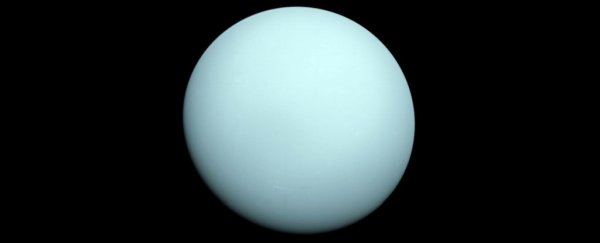Uranus has been sadly neglected. Probes have visited Mars, Venus, Saturn, Jupiter, and Mercury. Heck, even Jupiter's moons are getting their own spacecraft. But the ice giants Uranus and Neptune, in the distant reaches of our Solar System, have not had a single dedicated visitor.
In a new report laying out the top priorities for planetary science and astrobiology, a panel of experts from the US National Academies advises that this omission be rectified. For initiation within the next decade, the committee put a Uranus probe at top priority as the next planetary flagship mission.
The report is titled Origins, Worlds, and Life: A Decadal Strategy for Planetary Science and Astrobiology 2023–2032, an important once-a-decade survey prepared by the US National Academies of Sciences, Engineering, and Medicine at the request of NASA, to identify the most important scientific targets of the coming decade.
And now, it may be that Uranus's time has come.
"The committee prioritizes the Uranus Orbiter and Probe (UOP) as the highest-priority new Flagship mission for initiation in the decade 2023–2032," the committee wrote in its report.
This probe, the report elaborated, would perform a multi-year orbital tour of Uranus, probing its stinky atmosphere. The mission would provide an unprecedented wealth of information on ice giants in general, and Uranus and its moons in particular – one of the most intriguing and mysterious major objects in the Solar System.
There's no doubt Uranus is utterly weird. It's the only planet in the Solar System that's been tipped sideways, so that its rotational axis is almost parallel to the orbital plane. It's also leaking all over the place, its magnetic field is seriously off-kilter, it has rings like nothing else in the Solar System, and it's even emitting mysterious X-rays.
All this, the committee noted, suggests that Uranus warrants significant investigation, not just for its own sake, but for better understanding the evolutionary history of the entire Solar System – especially since the last probe to come close to the planet was Voyager 2 on a flyby in 1986.
The panel has identified several launch windows in the 2030s, with the earliest being 2031; planetary probes are a long game.
"Uranus is one of the most intriguing bodies in the Solar System," the scientists wrote. "Its low internal energy, active atmospheric dynamics, and complex magnetic field all present major puzzles.
"A primordial giant impact may have produced the planet's extreme axial tilt and possibly its rings and satellites, although this is uncertain. Uranus's large ice-rock moons displayed surprising evidence of geological activity in limited Voyager 2 flyby data, and are potential ocean worlds."
Ocean worlds are of great interest to astrobiologists. Scientists believe that on the ocean floors of these geologically active bodies, volcanic vents may allow entire ecosystems based on a chemosynthetic food web to thrive, much like hydrothermal vents here on Earth.
These bodies, of which several have been identified in the Solar System, are the most promising candidates for finding extraterrestrial life.
On that note, the committee identified ocean world Enceladus, a moon of Saturn, as its second-most top priority, with a mission named the Enceladus Orbilander. This ice-covered body has been observed venting plumes of vapor into space from its internal ocean. Sampling these plumes could assess the habitability of Enceladus' ocean, and perhaps even detect signs of life deep within.
A recommendation in the decadal report is a weighty one indeed, but that's no guarantee that a mission will be initiated. The previous report, Vision and Voyages for Planetary Science in the Decade 2013-2022, also recommended a Uranus mission, as well as an Enceladus mission, albeit at a lower priority.
The cost of a mission to Uranus could be over US$4 billion, but the potential scientific gain would be priceless. So, too, could be the gain from an in-depth exploration of Enceladus.
The two highest-priority missions in the previous survey were a Mars sample return mission, and a mission to Europa, an ice moon with a suspected internal ocean orbiting Jupiter. Both of those missions made the cut, and are currently in development. This bodes well for our future exploration of the outer Solar System.
Other recommendations in the new report included continuation of the Mars sample return mission; restoration of the Mars exploration program; continued support for lunar exploration; and, for the first time, improvement of NASA's program to find and track asteroids that pose a threat to life on Earth.
It may be a long road ahead to reach any or all of these goals. But the journey to the stars begins with small steps.
"This report sets out an ambitious but practicable vision for advancing the frontiers of planetary science, astrobiology, and planetary defense in the next decade," said astrophysicist Robin Canup of the Planetary Sciences Directorate at the Southwest Research Institute, and co-chair of the National Academies' steering committee for the decadal survey.
"This recommended portfolio of missions, high-priority research activities, and technology development will produce transformative advances in human knowledge and understanding about the origin and evolution of the Solar System, and of life and the habitability of other bodies beyond Earth."
You can download the full report for free from the National Academies website.
